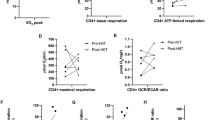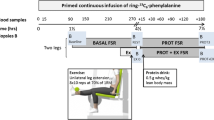Abstract
Purpose
Rheumatoid arthritis (RA) patients display high levels of oxidative stress. Transient exercise-induced increases in oxidative stress are thought to be adaptive in healthy populations. This study investigated the effect of exercise on markers of oxidative stress in RA, following acute exercise and a period of exercise training.
Methods
Acute exercise study: RA patients (N = 12, age: 56 ± 11) undertook a bout of exercise (30–40 min, 70 % VO2MAX), and blood samples were taken before and after exercise to assess markers of oxidative stress. Training study: RA patients (N = 19, age: 56 ± 10) were randomised into either a control or exercise group, who undertook 3 exercise sessions per week (30–40 min @70 % VO2MAX) for 3 months. Plasma markers of oxidative stress (protein carbonyls (PC), lipid hydroperoxides (LOOH), 3-nitrotyrosine (3-NT), total antioxidant capacity (TAC) and catalase (CAT) activity), inflammation (interleukin-8 (IL-8) and C-reactive protein (CRP)) and nitric oxide metabolites (NOx) were assessed before and after training.
Results
Acute exercise study: Protein carbonyls (PC) (+18 %) and NOx (+27 %) were significantly increased following exercise. Training study: 3-nitrotyrosine (3-NT) decreased (2.18 ± 1.78 to 1.10 ± 0.93 μM) in the exercise group only, alongside increases in aerobic fitness (24.45 ± 4.98 to 27.10 ± 4.51 ml/kg/min−1) and reductions in disease activity score (DAS: 3.47 ± 1.17 to 2.88 ± 0.76). PC, LOOH, TAC, IL-8, CRP and NOx concentrations, and CAT activity were unchanged in both groups.
Conclusions
Aerobic exercise training did not increase markers of oxidative stress in RA patients. 3-Nitrotyrosine and disease activity were decreased following exercise training.




Similar content being viewed by others
Abbreviations
- CAT:
-
Catalase
- CRP:
-
C-reactive protein
- CVD:
-
Cardiovascular disease
- DAS:
-
Disease activity score
- IL-8:
-
Interleukin-8
- LOOH:
-
Lipid hydroperoxides
- 3-NT:
-
3-nitrotyrosine
- NO:
-
Nitric oxide
- NOx:
-
Nitric oxide metabolites
- O2 − :
-
Superoxide
- ONOO− :
-
Peroxynitrite
- PC:
-
Protein carbonyls
- RA:
-
Rheumatoid arthritis
- TAC:
-
Total antioxidant capacity
References
ACSM (2005) Guidelines for exercise testing and prescription, 7th edn. Lippincott Williams & Wilkins, Philadelphia, pp 286–299
Arnett F (1988) The American Rheumatism association 1987 revised criteria for the classification of rheumatoid arthritis. Arthritis Rheum 31:315–324
Avogaro P, Bon GB, Cazzolato G et al (1986) Plasma malondialdehyde in coronary patients and in normal people at rest and after exercise. Cardiovas Med Surg 13:291–296
Babior BM, Kipnes RS, Curnutte JT (1973) Biological defense mechanisms. The production by leukocytes of superoxide, a potential bactericidal agent. J Clin Investig 52:741–744
Beckman JS, Beckman TW, Chen J et al (1990) Apparent hydroxyl radical production by peroxynitrite: implications for endothelial injury from nitric oxide and superoxide. Proc Natl Acad Sci USA 87:1620–1624
Benzie IF, Strain JJ (1996) The ferric reducing ability of plasma (FRAP) as a measure of “antioxidant power”: the FRAP assay. Anal Biochem 239:70–76
Berzosa C, Cebrian I, Fuentes-Broto L et al (2011) Acute exercise increases plasma total antioxidant status and antioxidant enzyme activities in untrained men. J Biomed Biotechnol 1–7
Biemond P, Swakk AJ, Penders JM et al (1986) Superoxide production by polymorphonuclear leucocytes in rheumatoid arthritis and osteoarthritis: in vivo inhibition by the antirheumatic drug piroxicam due to interference with the activation of the NADPH-oxidase. Ann Rheum Dis 45:249–255
Bloomer RJ, Goldfarb AH, Wideman L et al (2005) Effects of acute aerobic and anaerobic exercise on blood markers of oxidative stress. J Strength Cond Res/Natl Strength Cond Assoc 19:276–285
Bloomer RJ, Davis PG, Consitt LA, Wideman L (2007) Plasma protein carbonyl response to increasing exercise duration in aerobically trained men and women. Int J Sports Med 28:21–25
Buss H, Chan TP, Sluis KB et al (1997) Protein carbonyl measurement by a sensitive ELISA method. Free Radical Biol Med 23:361–366
Carty JL, Bevan R, Waller H et al (2000) The effects of vitamin C supplementation on protein oxidation in healthy volunteers. Biochem Biophys Res Commun 273:729–735
Clarkson P, Montgomery HE, Mullen MJ et al (1999) Exercise training enhances endothelial function in young men. J Am Coll Cardiol 33:1379–1385
Dalle-Donne I, Aldini G, Carini M et al (2006) Protein carbonylation, cellular dysfunction, and disease progression. J Cell Mol Med 10:389–406
Danesh J, Pepys MB (2009) C-reactive protein and coronary disease: is there a causal link? Circulation 120:2036–2039
El-Saadani M, Esterbauer H, El-Sayed M et al (1989) A spectrophotometric assay for lipid peroxides in serum lipoproteins using a commercially available reagent. J Lipid Res 30:627–630
Farrell AJ, Blake DR, Palmer RM, Moncada S (1992) Increased concentrations of nitrite in synovial fluid and serum samples suggest increased nitric oxide synthesis in rheumatic diseases. Ann Rheum Dis 51:1219–1222
Fu Y, Luo N, Lopes-Virella MF (2002) Upregulation of interleukin-8 expression by prostaglandin D2 metabolite 15-deoxy-delta12, 14 prostaglandin J2 (15d-PGJ2) in human THP-1 macrophages. Atherosclerosis 160:11–20
Gielen S, Adams V, Möbius-Winkler S et al (2003) Anti-inflammatory effects of exercise training in the skeletal muscle of patients with chronic heart failure. J Am Coll Cardiol 42:861–868. doi:10.1016/S0735-1097(03)00848-9
Gleeson M, Robertson JD, Maughan RJ (1987) Influence of exercise on ascorbic acid status in man. Clin Sci (Lond) 73:501–505
Goto S, Naito H, Kaneko T et al (2007) Hormetic effects of regular exercise in aging: correlation with oxidative stress. Appl Physiol Nutr Metab 32:948–953
Griffiths HR, Aldred S, Dale C et al (2006) Homocysteine from endothelial cells promotes LDL nitration and scavenger receptor uptake. Free Radical Biol Med 40:488–500
Häkkinen A, Sokka T, Kautiainen H et al (2004) Sustained maintenance of exercise induced muscle strength gains and normal bone mineral density in patients with early rheumatoid arthritis: a 5 year follow up. Ann Rheum Dis 63:910–916
John H, Kitas G, Toms T, Goodson N (2009) Cardiovascular co-morbidity in early rheumatoid arthritis. Best Pract Res Clin Rheumatol 23:71–82
Kargotich S, Goodman C, Keast D et al (1997) The influence of exercise-induced plasma volume changes on the interpretation of biochemical parameters used for monitoring exercise, training and sport. Sports Med 7:185–191
Kaur H, Halliwell B (1994) Evidence for nitric oxide-mediated oxidative damage in chronic inflammation. Nitrotyrosine in serum and synovial fluid from rheumatoid patients. FEBS Lett 350:9–12
Khassaf M, McArdle A, Esanu C et al (2003) Effect of vitamin C supplements on antioxidant defence and stress proteins in human lymphocytes and skeletal muscle. J Physiol 549:645–652
Kitas GD, Gabriel SE (2011) Cardiovascular disease in rheumatoid arthritis: state of the art and future perspectives. Ann Rheum Dis 70:8–14
Lee DM, Weinblatt ME (2001) Rheumatoid arthritis. Lancet 358:903–911
Mapp PI, Grootveld MC, Blake DR (1995) Hypoxia, oxidative stress and rheumatoid arthritis. Br Med Bull 51:419–436
Maruyama W, Hashizume Y, Matsubara K, Naoi M (1996) Identification of 3-nitro-L-tyrosine, a product of nitric oxide and superoxide, as an indicator of oxidative stress in the human brain. J Chromatogr B Biomed Appl 676:153–158
McAnulty SR, McAnulty LS, Morrow JD et al (2005) Effect of daily fruit ingestion on angiotensin converting enzyme activity, blood pressure, and oxidative stress in chronic smokers. Free Radic Res 39:1241–1248
Metsios GS, Stavropoulos-Kalinoglou A, Veldhuijzen van Zanten JJCS et al (2008) Rheumatoid arthritis, cardiovascular disease and physical exercise: a systematic review. Rheumatology (Oxford) 47:239–248
Metsios GS, Stavropoulos-Kalinoglou A, Veldhuijzen van Zanten JJCS et al (2013) Individualised exercise improves endothelial function in patients with rheumatoid arthritis. Ann Rheum Dis 1–4
Miranda KM, Espey MG, Wink DA (2001) A rapid, simple spectrophotometric method for simultaneous detection of nitrate and nitrite. Nitric Oxide 5:62–71
Miyata T, Ishiguro N, Yasuda Y et al (1998) Increased pentosidine, an advanced glycation end product, in plasma and synovial fluid from patients with rheumatoid arthritis and its relation with inflammatory markers. Biochem Biophys Res Commun 224:45–49
Moshage H, Kok B, Huizenga JR, Jansen PL (1995) Nitrite and nitrate determinations in plasma: a critical evaluation. Clin Chem 41:892–896
Nishiyama Y, Ikeda H, Haramaki N et al (1998) Oxidative stress is related to exercise intolerance in patients with heart failure. Am Heart J 135:115–120
Prevoo MLL (1995) Modified disease activity scores that include twenty-eight-joint counts. Arthritis Rheum 38:44–48
Rall LC, Roubenoff R, Meydani SN et al (2000) Urinary 8-hydroxy-2′-deoxyguanosine (8-OHdG) as a marker of oxidative stress in rheumatoid arthritis and aging: effect of progressive resistance training. J Nutr Biochem 11:581–584 S0955-2863(00)00123-6
Ristow M, Birringer M, Kiehntopf M et al (2009) Antioxidants prevent health-promoting effects. PNAS 106:8865–8870
Sarban S, Kocyigit A, Yazar M, Isikan UE (2005) Plasma total antioxidant capacity, lipid peroxidation, and erythrocyte antioxidant enzyme activities in patients with rheumatoid arthritis and osteoarthritis. Clin Biochem 38:981–986
Seven A, Guzel S, Aslan M, Hamuryudan V (2008) Lipid, protein, DNA oxidation and antioxidant status in rheumatoid arthritis. Clin Biochem 41:538–543
Shephard RJ, Balady GJ (1999) Exercise as cardiovascular therapy. Circulation 99:963–972
Smith PK, Krohn RI, Hermanson GT et al (1985) Measurement of protein using bicinchoninic acid. Anal Biochem 150:76–85
Stavropoulos-Kalinoglou A, Metsios GS, van Zanten JJCV et al (2012) Individualised aerobic and resistance exercise training improves cardiorespiratory fitness and reduces cardiovascular risk in patients with rheumatoid arthritis. Ann Rheum Dis 1–7
Stewart LK, Flynn MG, Campbell WW et al (2007) The influence of exercise training on inflammatory cytokines and C-reactive protein. Med Sci Sports Exerc 39:1714–1719
Trøseid M, Lappegård KT, Claudi T et al (2004) Exercise reduces plasma levels of the chemokines MCP-1 and IL-8 in subjects with the metabolic syndrome. Eur Heart J 25:349–355
Turner JE, Bosch JA, Drayson MT, Aldred S (2011) Assessment of oxidative stress in lymphocytes with exercise. J Appl Physiol 111:206–211 (Bethesda, Md: 1985)
Vasanthi P, Nalini G, Rajasekhar G (2009) Status of oxidative stress in rheumatoid arthritis. Int J Rheum Dis 12:29–33
Wadley AJ, Veldhuijzen van Zanten JJCS, Aldred S (2012) The interactions of oxidative stress and inflammation with vascular dysfunction in ageing: the vascular health triad. AGE 35:705–718
Wattanapitayakul SK, Weinstein DM, Holycross BJ, Bauer JA (2000) Endothelial dysfunction and peroxynitrite formation are early events in angiotensin-induced cardiovascular disorders. FASEB J Off Publ Fed Am Soc Exp Biol 14:271–278
Wink DA, Hanbauer I, Grisham MB et al (1996) Chemical biology of nitric oxide: regulation and protective and toxic mechanisms. Curr Top Cell Regul 34:159–187
Winrow VR, Winyard PG, Morris CJ, Blake DR (1993) Free radicals in inflammation: second messengers and mediators of tissue destruction. Br Med Bull 49:506–522
Conflict of interest
None of the authors declare a conflict of interest.
Author information
Authors and Affiliations
Corresponding author
Additional information
Communicated by Fabio Fischetti.
Rights and permissions
About this article
Cite this article
Wadley, A.J., van Zanten, J.J.C.S.V., Stavropoulos-Kalinoglou, A. et al. Three months of moderate-intensity exercise reduced plasma 3-nitrotyrosine in rheumatoid arthritis patients. Eur J Appl Physiol 114, 1483–1492 (2014). https://doi.org/10.1007/s00421-014-2877-y
Received:
Accepted:
Published:
Issue Date:
DOI: https://doi.org/10.1007/s00421-014-2877-y




